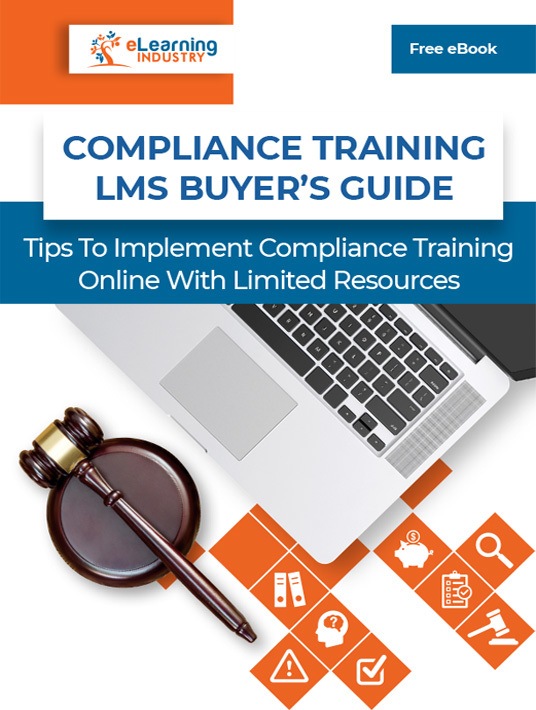Using Compliance Training Software Vs. ILT Sessions
Instructor-Led-Training (ILT) is the more conventional approach to work-force development. It’s not that it’s traditional or old-fashioned. Training consultants often use top technology to facilitate sessions. But when weighed against eLearning, there are a number of downsides. Namely, cost and overall training time. In what specific ways does making the switch to compliance training software trim expenses? Here are 5 notable advantages of choosing a compliance training LMS over ILT sessions.

1. Venues And Materials
When you call in external trainers, you probably have to hire a room for training sessions. Study documents have to be printed out. Or maybe the trainer can share documents via email or flash drives. Which means everyone needs a laptop or tablet to access training materials. This cost can be reduced by having the instructor come to your office. It eliminates venue rental expenses, but you still have to pay for the consultant’s food and board in addition to their fee. And training on-site means regular work stops for the day. So that’s a direct loss of income via billable time diverted into training. Online compliance training solves both challenges in one go because employee training participants can study after hours, on their own, at home. No need to hire an on-site instructor or print out manuals. As all the resources are centrally located in your compliance training LMS. Furthermore, these resources are personalized so that every member of your organization can focus on their areas for improvement.
2. Reduced Seat Time
Along the same lines, software-based lessons are generally compressed into shorter units. A typical 3-day seminar or 2-week workshop can be broken down to 5-minute sessions. Cumulative study time may be the same. You might study for half an hour a day, spread over 3 months. Most of the training will be completed in the after-work commute or before colleagues arrive, while the office is still quiet. Even if they train on the clock during scheduled compliance sessions, it still involves fewer payroll hours. Employees can plan out their training, meaning they’ll still beat your compliance deadline. But they’ll be more focused because they have small chunks. It’s easier to maintain attention levels. Especially when compared to sitting in a conference room for hours as a trainer drones on. When staff members are receiving your lessons in bits, it’s less dreary and taxing, which means that they’ll retain more information.
3. No Travel Expenses
Getting employee training participants to a venue, or bringing a trainer to your office site, can get pricy. If the consultant is premium, you may have to book them, first class. If you’re taking your staff to an external venue, then costs rise for each individual employee. No matter what wholesale discount you get, the costs will still be hundreds of dollars higher than per-user software fees. You also have to factor in the cost of time away from their desks. This applies both for internal and external ILT. Compliance training software doesn’t require any kind of transport cost. Not even for shipping. You’ll get your link via email, so you just click to begin. Open source or self-hosted platforms may need technical installation, but there’s still no travel bill.
4. Real-World Application
It’s easy to assume the purpose of compliance regulation is to make people money. Why else would the penalties be so high? Well, the steepness of non-compliance fines isn’t gauged on your breaking said rules. It’s designed to deter you. They don’t want to make that money, because that would mean preventable problems have occurred. And sometimes, repairing the damage caused by non-compliance costs even more than the fines themselves. Compliance training software allows you to see all these real-world consequences. Digital techniques can extrapolate in more breadth and depth than the best consultant. That’s because of tools like interactive case studies, simulations, and multimedia formats. These can combine to mitigate risks and eliminate the need to pay penalties.
5. Ease Οf Αssessment
To evaluate ILT, you might give employee training participants an exit quiz, but this rarely happens. Instead, they’ll have a completion certificate. And while these prove your staff was present, it doesn’t guarantee knowledge transfer or retention. You won’t really know how good the course was until your learners sit their regulatory compliance exam. And since these exams often cost money, sitting and flunking is just added expense. With online training software, you can include a pop quiz at the start and end of each unit. You can gauge the chapters where they stumbled. They took longer to complete them or kept reviewing certain pages. So long before the course is over, you can identify trouble areas and provide extra help. This ensures your training budget is put to good use. Plus, your compliance training software has built-in reports that allow you to monitor every aspect of their performance. Even if they ace the exam, you can still identify areas for improvement that might lead to costly compliance fines. An LMS gives you the power to dig deeper into their performance and detect emerging gaps.
Anecdotally, and even logically, online training via software is cheaper than training in person. But can you identify the particular points where those corporate compliance training costs come down? You don’t have to pay for venues, materials, or transport. Staffers don’t have to take time off work, so you don’t lose billable hours. It’s easier to offer contextual lessons with real-world applications. Plus, deeper evaluation modules reduce the risk of failing compliance tests and incurring penalties despite weeks of pricy ILT.
Have you ever wondered what compliance training is and how you can implement a compliance training LMS in your workplace without going over your budget? Download our eBook Compliance Training LMS Buyer's Guide: Tips To Implement Compliance Training Online With Limited Resources and discover how to cut costs, mitigate risks, train your employees, monitor their performance, and maintain your company’s high standards.

